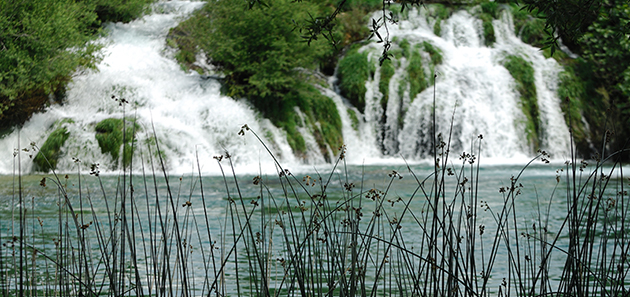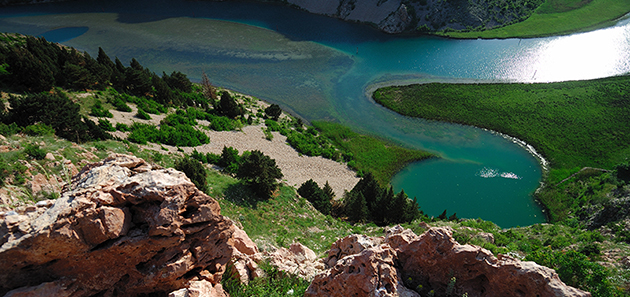





Nature › Caves and rivers
„...we may well say that the underground of Paklenica is just as beautiful, or even more beautiful than its forest and steep cliffs above the ground.“ (Josip Poljak 1929.)
Among the many karstic phenomena of the Velebit and Paklenica caves and spits are one oft he most significant ones. So far, 90 speleological objects have been explored in the NP Paklenica. In some of them were found 30.000-year old cave bear's (Ursus spelaeus) skull and also the fragments of ceramics and bones which indicates a temporary stay of people back int he Copper Age and Bronze Age (3.000-1.000 BC). Some of the deepest pits in Croatia are settled in the NP Paklenica, more then 500m deep.
The local people had been using the caves as shelters up to couple of decades, so we can still find supporting masonry and outbuidings on the entrances of some caves. These are mostly small facilities that were use din the past by the local inhabitants as shelters for cattle and other goods.
The specific form of speleological object are ice caves and pits where ice or snow stay almost the entire year round and they are located on the peaks oft he Velebit. Particular ice caves are used as a source of drinking water during the summer grazing season.
The underground fauna is particularly rich and diverse and it has many endemic species, like endemic spider (Histopona egonpretneri), subterranean freshwater amphipod (Bogidiella sketi), cave beetle (Astagobius angustatus vukusici) and others.
Caving visits and the gathering of biological and geological material is not permitted without earlier notification and permission!
MANITA PEĆ
Because of the richness of its decorations (stalactites, stalagmites and other) the cave Manita peć has been thrilling its visitors since 1937. when the visits started. It is situated at an altitude of 570 meters above the sea level and the walk to the entrance lasts about 1,30h. The cave is 175m long and divided into 2 halls abundant with ornaments like stalagmites, stalactites, dripstone pillars and cascades. Did you know that it takes 10-30 years for an cave ornament to grow by just a millimeter, depending on the water dripping speed?
You will spend about 30 minutes in the cave beeing escorted by a guide and you will get acquianted with this interesting underground world. The temperature int he cave is around 10C all year round, so it is reccommended to bring appropriate clothing, even in the warmer part of the year.
The terms for the Cave visiting are:
April: on Saturday 10.00 am - 1.00 pm
May: on Wednesday and Saturday 10.00 am - 1.00 pm
June, October: on Monday, Wednesday and Saturday 10.00 am - 1.00 pm
July, August, September: every day 10.00 am - 1.00 pm
For other terms is necessary to make an announcement.
www.paklenica.hrMODRIČ ŠPILJA
Modrič Cave lies at 30 meters above the sea level, between Rovanjska and the hamlet of Modrič. It was discovered in 1985 by the spelunker Silvije Legović from Poreč, who explored its underground passages together with other members of "Proteus" and "Liburnija" spelunking clubs from Poreč and Zadar. The total length of explored cave channels currently stands at 829 meters. Its interior abounds in beautiful, spacious halls, decorated by numerous speleothems – stalactites, stalagmites, stalagmitic columns and curtains. The cave is relatively dry, and its temperature is a pleasant 17 –19 ˚C throughout the year.
Modrič Cave stands out among others cave of Velebit by its natural beauty, which has been preserved in full splendor. Because of that, soon after its discovery the cave was granted status of geomorphological monument.
Tourist visits are possible only by arrangement. The visit is not a typical tourist visit, this is a real speleoadventure!Tthere are no stairs, marked paths or installed electric lights inside the cave and, it is necessary to wear overalls and a helmet with a carbide lamp to walk freely around the cave (included in arrangement).
www.zara-adventure.hrCEROVAČKE ŠPILJE
Of all the fascinating attractions the mountain of Velebit hides in its underworld, Cerovac Caves belong to its most intriguing ones. For their unique natural beauty, richness of cave ornaments and numerous findings that belong to the ancient times, Cerovac Caves received legal protection in 1961 as geomorphological natural monument. This cave complex is located near the town of Gračac int he massive oft he South Velebit. It comprises three speleological structures: the Upper, Middle and Lower Caves with a total length of approx.4km. Apart from that, these caves are one of the largest cave bear site sin Croatia as well. You can see traces of bears` „sharpening“ on cave rocks even today, which survived as evidence of bears moving along the cave walls. Among the artifacts discovered int he caves, including numerous archaelogical finds from the Iron Age/fragments of ceramic dishes, bronze, bone and stone utensils), was also a fossil human bone, bown awls and flint scrapers found in the Cave Bear Hunter`a Hall, which testify to the human presence from the Upper Paleolithic period.
The average temperature in the caves lies at 11C, so warm clothings, a head covering and a pair of comfortable hiking shoes are needed. A guided tour of the caves takes about an hour.
The Cerovac Caves are located 4 km from Gračac along the road towards Knin. If you intend to take the motorway, please take the exit to Sveti Rok. The distance between Sveti Rok and Gračac is 25 km.
At the moment, Cerovac Caves are under concession. For all further information, reservation enquiries etc., please contact:
Park prirode Velebit
Phone +385 99 81 44 724
mile.milkovic@pp-velebit.hr
www.pp-velebit.hr
ZRMANJA
Below the southern slopes of Velebit, carved deeply into the canyon of a very impassable region, flows the Zrmanja River. The river delights with its crystal clear waters winding through an imposing, 200 metre deep canyon, that ends its course mixing with the waters of the sea off the shores of the town of Novigrad. The upper reaches of the river abound in travertine waterfalls, among which the most attractive is the 11 metre high Veliki buk, while Jankovića buk, adorned with the imposing remains of old mills, is a favourite excursion area. This area is great for rafting and canouing excursions.
After the river quietly flows into the sea through several-hundred meters wide delta. This part of the river you can enjoy sailing from Starigrad-Paklenica. We reccomend to visit Novigrad – an ancient fishing settlement located at the very mouth of the river, and the fortifications of the Kurjaković princes above the town of Obrovac, also situated on the banks of the Zrmanja River.
KRUPA
Krupa is the longest and richest in water of all of Zrmanja's confluents. Along its short watercourse of some 11 km, Krupa formed 19 beautiful cascades. The most beautiful part of Krupa is its travertine barrier named Deveterac emerge. Deveterac ("Niner") was named after the nine travertine cascades which end with a13m high waterfall over which Kuda's Bridge was constructed. It was built in a dry wall technique, by the end of 18th and the beginning of 19th century, constructed of 12 arcs out of travertine blocks and the same number of stone pillars.
The legend tells that the bridge was constructed by the amorous youngling Kude who built it in order to cross the river which separated him from his beloved one so the bridge was named after him. Today the bridge is preventively protected as a cultural monument.








 MANITA PEĆ
MANITA PEĆ
 MODRIČ ŠPILJA
MODRIČ ŠPILJA
 CEROVAČKE ŠPILJE
CEROVAČKE ŠPILJE
 ZRMANJA
ZRMANJA
 KRUPA
KRUPA